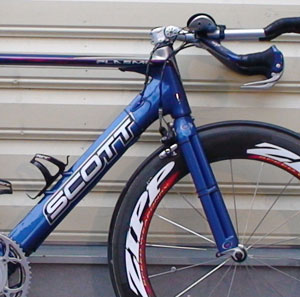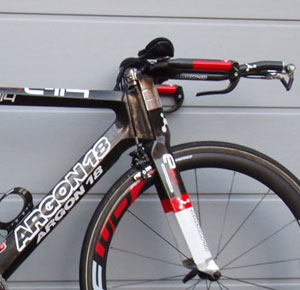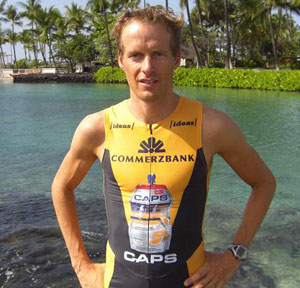Timo Bracht’s Cucuma/Walser
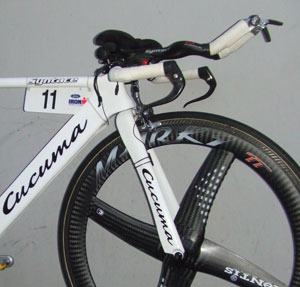
For the new series "the bikes of the pros" we want to know more about the Cucuma/Walser of Timo Bracht (GER). He won Ironman Europe in 2007 and he talks candidly to Slowtwitch about his ride.
ST: Why this Cucuma/Walser frame versus any other?
Timo: I rode a Litespeed Blade from 2003-2006 and have won several Ironman titles on that bike. But I really wanted to develop further, especially in terms of an aerodynamic position on the bike. At the end of 2006 I got to experience a Walser frame for the first time, and together with Cucuma and SRM we went to a track a did a standard aero test. Basically we rode 45km/h for 3 minutes in various positions.
Your average effort and power was then analyzed for these 3 minute efforts and I saw how much faster the Walser was in comparison to the Blade. The results were such that I decided to ride a Walser in 2007. During the season I realized that the best aerodynamic position could still be optimized in terms of biodynamic. I didn’t really get any personal records this year on my bike, but was able to save enough power during Ironman Frankfurt, that I came off the bike in good shape and was able to run a 2:47 marathon.
Still though I am a bit limited because of the narrow bottom bracket and rear wheel spacing. I also would really need a bit shorter top tube and a 1” steerer is somewhat limiting too. I talked to Cucuma about these things as they distribute the frame. We are now ready to build a stock frame with standard spacing and that should be available by February 2008. That should then also get rid of some tolerance issues. The Walsers of Ullrich, Thuerig, Vytrisal, Team Gerolsteiner and myself were all hand made and one of a kind. By the end of the year I should be able to test the first prototype of the new bike though.
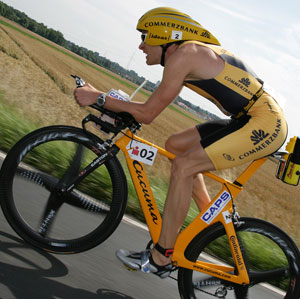
ST: Can you tell us how were you fitted to this bike?
Timo: As I told you before we really tested my aero position on the track, and during that time we also tested various handle bar positions. Walser builds the frame in 3 sizes and only the top tube varies on them. The seat tube angle is 73 degrees and the head tube length is 110mm and together with the long top tube and my big bar drop (15cm) I am very flat and aero on the bike. Plus I am constantly fiddling with my setup and have modified the bike with different stems and also various saddle angles. This process though is still not done. FYI, I have a yellow one and a white one 🙂
ST: Please give us also some of your likes and dislikes of the bike.
Timo: I really like the very deep aero position on the bike and I really like the comfort of the ride. Maybe because of the 73-degree angle? I don’t care so much for the way the saddle is fastened and also not the very long top tube.
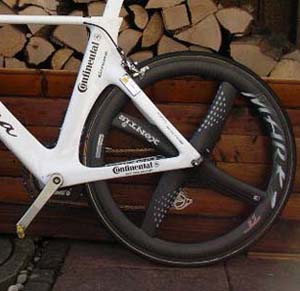
ST: Why these wheels versus any other?
Timo: I have been using Xentis wheels since 2003 and really have had all major successes on Xentis. Now for the Walser I need a more narrow back wheel (10mm) and only Xentis makes one like that. The new Xentis TT wheels are more aerodynamic, very tough and actually work great for racing and training.
ST: Can you tell us why you chose this bar setup?
Timo: Just like some others I switched to S-bends a few years ago. For a few kilometers they are pretty nice, but for longer distance? Just before Ironman Frankfurt I tested a Syntace C2 setup and had a good feeling again in the aero position. Now I am using the new Syntace C3 and really like the way it feels. It actually feels perfect in combination with the Stratos base bar and quality is 100%. Plus of course some of that is psychological, as I have won all my titles on Syntace bars. They are a bit tall, but I utilize shallow pads and a very flat (negative) stem.
ST: What about the tires you use, why did you choose them?
Timo: The new Conti 4000s roll much better than the Comp ones and offer the same flat tire protection. In Germany Conti is very big and I feel very good about Conti’s quality.
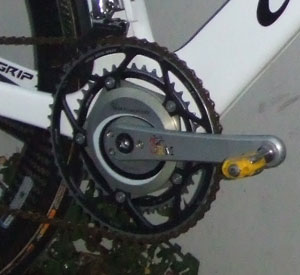
ST: Have you used other power meters before? How does your SRM system compare?
Timo: I have been riding SRM since 2005 and am very happy with it plus I have also used the Ergomo system before. A practical reason to ride the SRM system though is as follows. Because of the narrow 50mm bottom bracket the only power meter system that works for me is SRM. Thus I have installed SRM on my training bikes too, and really like that SRM is very accurate, reliable and that the charge lasts a long time. Not so great are the very expensive spare parts and the battery replacement.
ST: Why did you pick this saddle?
Timo: I have always played around with different saddles and until more recently I actually rode a Velo saddle. Just before Hawaii I tried the Fizik Aliante of my mechanic and it felt very good, so I decided to keep it on. The Fizik folks saw me with it and wanted me to have a newer model, but I kept riding on the somewhat older looking model.
I am still on the search for the perfect saddle to ride a TT.
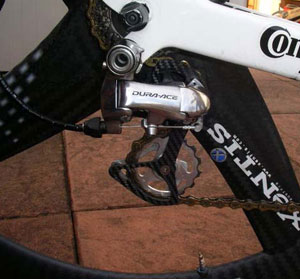
ST: You seem to have a few weight weenie parts on your bike such as the KMC chain and the Berner derailleur. Any particular reason other than weight?
Timo: The chain is light, but that is not the reason why I chose it. The KMC chain runs very smooth in combination with the Berner derailleur und thus it is easier to pedal. On my TT bike I am really not a weight weenie, but I kind of am on my road bike.
Physical dimensions Timo Bracht
Height: 182 cm
Weight: 68 kg
Detailed numbers/data of the Cucuma/Walser:
Frame: Walser / Cucuma
Size: L
Bar drop: 15cm
Saddle setback: 2cm (tip to center of BB)
Saddle height: 76cm (center of BB to center of saddle)
Fork: Easton Aero EC90 custom painted
Seat post: Walser/ Cucuma
Saddle: Fizik Aliante
Stem: Syntace F 119 custom (60 degrees)
Aero bars: Syntace C3
Base bar: Syntace Stratos CX
Cranks/ power meter: SRM 175cm
Front derailleur: Shimano Dura Ace
Rear derailleur: Berner/ Cucuma custom
Chain: KMC X10SL Gold
Brake levers: SRAM
Brakes: Shimano Dura Ace
Aero wheels: Xentis Mk 1 TT
Tires: Continental 4000 S tubular
Bottle cages: XLAb Carbon Wing
Pedals: Speedplay Zero
Complete bike weight: 8.9kg



